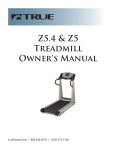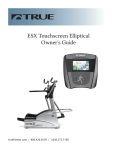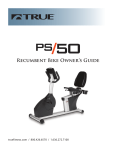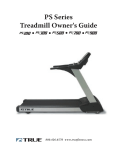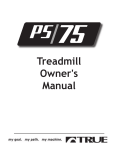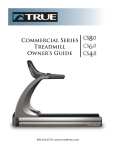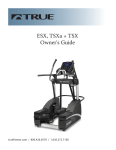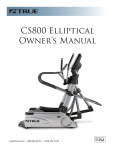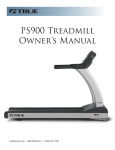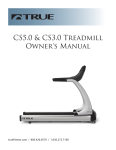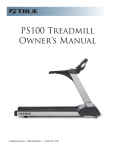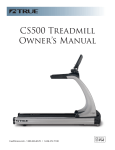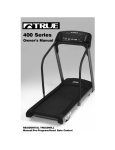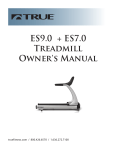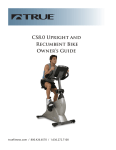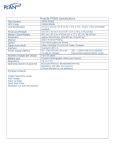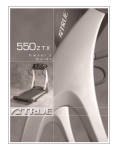Download True Fitness PS1100 User's Manual
Transcript
Treadmill Owner's Guide truefitness.com / 800.426.6570 / 1.636.272.7100 Thank You For Selecting True In 1981, Frank Trulaske launched TRUE Fitness®, and began manufacturing handcrafted treadmills. His team’s obsession with quality has propelled TRUE to the top of the fitness industry and has created one of America’s oldest, largest and most respected fitness equipment manufacturers. While TRUE has expanded its line of products, intensive quality control standards guarantee excellence in every phase of production. This results in the finest products available in the marketplace. “Our original goal was to build the world’s best fitness equipment, and today we believe we’re doing it!” TRUE is the choice for workouts among beginners, rehab patients and top athletes worldwide. Over the years, TRUE -Frank Trulaske has designed, developed, Today TRUE Fitness patented and fabricated offers a full line of many new cutting-edge premium elliptical innovations for their products. Such trainers, treadmills, upright and advancements include groundrecumbent bikes, and flexibility breaking new features, state-of-theequipment. art manufacturing components, and technological breakthroughs. Review for Your Safety Important Safety Instructions When using this exercise machine basic precautions should always be followed, including the following: Obtain a medical exam before beginning any exercise program. If at any time during exercise you feel faint, dizzy, or experience pain, stop and consult your physician. Read and understand all instructions and warnings prior to use. Obtain proper instruction prior to use. Inspect the treadmill for incorrect, worn, or loose components and do not use until corrected, replaced, or tightened prior to use. Do not wear loose or dangling clothing while using the treadmill. Care should be used when stepping on or stepping off the treadmill. Read, understand and test the emergency stop procedures before use. Disconnect all power before servicing the treadmill. Do not operate outdoors or in damp or wet locations. Do not exceed maximum user weight of 350 lbs. Keep the top side of the moving surface clean and dry. Keep children and animals away. All exercise equipment is potentially hazardous. If attention is not paid to the condition of the equipment, serious injury or death could occur. PS900, PS1100 Treadmill Owner’s Guide 3 Quick Start Quick Start into a manual workout by pressing , or set up a different workout by pressing a workout key and adjusting the settings as necessary. Before Your Workout You can fine tune your workout setup by repeatedly pressing to proceed to the next setting. Your workout starts only when you press . Adjust speed or grade at any time by using the dedicated speed and keys on the lower keypad. During Your Workout Change workouts during your workout by pressing a program key. Pause your workout by pressing . PS900, PS1100 Treadmill Owner’s Guide 4 Table of Contents Quick Start .......................................................................................4 1. Using Your Treadmill .................................................................6 Basic operation (except console) 2. Heart Rate Control......................................................................14 Foolproof heart rate feedback workouts 3. User Workouts............................................................................20 Describes each key and data display feature 4. Fitness Test...................................................................................22 Gerkin Fitness Test 5. Designing an Exercise Program................................................25 6. Care and Maintenance...............................................................33 Appendix A......................................................................................37 Target Heart Rate Chart Appendix B.......................................................................................39 Mets Table Appendix C.......................................................................................41 Treadmill Specifications Specifications/Features/Software are subject to change PS900, PS1100 Treadmill Owner’s Guide 5 Chapter One Basic Operation In This Chapter: Starting and Stopping the Treadmill Using the Keyboard Manual Operation Heart Rate Monitoring Contact Heart Rate Pre-Set Workouts Special Workouts Chapter 1: Basic Operation Chapter 2: Heart Rate Control Chapter 3: User Workouts Chapter 4: Fitness Test Chapter 5: Designing an Exercise Program Chapter 6: Care and Maintenance Starting and Stopping the Treadmill chapter One: Basic Operation Place your feet on the straddle covers. Attach the safety lanyard to your waistband. Place the safety key on the key holder. Set up your workout and press . Starting And Stopping Your Treadmill Safely Stop the treadmill by reducing speed to 2 mph, then press . PS900, PS1100 Treadmill Owner’s Guide 7 Using the Keyboard chapter One: Basic Operation Selecting Workouts: Press any of the workout keys and press to begin your workout using the default settings. Using the Keyboard Before pressing , you may adjust other settings like Workout Time and Body Weight, pressing after adjusting each setting. Press at any time to begin your workout. Note that HRC® workouts require settings adjustments. Adjusting Settings: Use the keys to adjust numeric settings. Press to accept each settings adjustment. Primary Controls: During your workout, press to stop the treadbelt and pause your workout. Press to resume your workout. Press and hold to clear your workout. Safety Lanyard: This magnetized cord must be in place on the treadmill balance bar location, and should be attached to your clothing. The treadmill will not operate if the lanyard is not attached. PS900, PS1100 Treadmill Owner’s Guide 8 Manual Operation chapter One: Basic Operation Press Quick Start: Start the treadbelt at 0.5 mph at the default workout time of 30 minutes. OR... Manual Operation Details Setting Time or Distance Targets: Enter your weight and press . Press for manual workout. Now either enter a workout time and press , or press to be prompted for a target distance. You can keep adjusting your workout setup by repeatedly pressing . Your workout starts only when you press . PS900, PS1100 Treadmill Owner’s Guide 9 Heart Rate Monitoring chapter One: Basic Operation This treadmill can monitor your heart rate using either the chest strap provided with the treadmill or the metal grips on the hand rails (called contact heart rate, or CHR pads). A chest strap transmits your heart rate to the treadmill via radio, and the CHR pads connect to a special computer circuit to extract your heart rate. Monitoring Your Heart Rate Although this treadmill functions fine without using the heart rate monitoring feature, this kind of monitoring gives you valuable feedback on your effort level. Chest strap monitoring also allows you to use Heart Rate Control, the most advanced exercise control system available. When you wear a Polar® or compatible transmitter strap (included), the treadmill will display your heart rate as a digital beats-per-minute (bpm) readout. Chest Strap Heart Rate Monitoring The transmitter strap should be worn directly against your skin, about one inch below the pectoral muscles/breast line (see picture). Women should be careful to place the transmitter below their bra line. Some moisture is necessary between the strap and your skin. Sweat from your exercise works best, but ordinary tap water may be used prior to your workout if desired. PS900, PS1100 Treadmill Owner’s Guide 10 Contact Heart Rate chapter One: Basic Operation The contact heart rate (CHR) system lets you monitor your heart rate without wearing a strap. Gently grasp the contact heart rate pads. Contact Heart Rate (CHR) During this time, the system is analyzing and locking in your heart rate. Within about 15 seconds, your digital heart rate in beats-per-minute (bpm) should be displayed. Important: The CHR System should only be used at speeds of 4 mph or lower. Above this speed the CHR accuracy is unavoidably unreliable due to large muscle movements. 1. Exercise with smooth body motions. 2. Breathe smoothly and regularly, and avoid talking. (Talking will cause unrepresentative heart rate spikes of 5 to 10 bpm.) 3. Grip the pads lightly, not tightly. 4. Make sure your hands are clean and free of both dirt and hand lotions. A Note on CHR Accuracy For Best CHR Results CHR monitoring may be a bit less accurate than a chest strap, since the heart rate signals are much stronger at the chest. About 5% of the population cannot be picked up by any CHR system. This is because their heart is positioned in a more up-anddown manner in their chest, as opposed to leaning over to one side. When using a Heart Rate Control workout, it is best to use chest strap monitoring. These workouts work best with the extra accuracy gained from a chest-contact heart rate monitoring system. PS900, PS1100 Treadmill Owner’s Guide 11 Pre-Set Workouts chapter One: Basic Operation Each workout has a four-minute warm up and a two-minute cool down. Speed or incline changes stay in effect until the next change requested by the program. Changing the default workout time adds or removes segments; it does not stretch or compress the workout profile. Pre-Set Workouts Change workout levels during your workout by pressing the workout key you are using, adjusting the numeric level, then pressing . Change to a new pre-set workout during your workout by pressing a new Program Profile key and pressing . In a walking workout, all speeds are under 4 mph. Increasing levels increases speed from 2 to 4 mph and incline from 4% to 10%; speed and incline stay constant in the work section. Speed or incline changes in the work section are permanent. Walking: Calorie Burn Changes in Incline Walking intervals with incline alternate between hills and nearly flat in two-minute segments. Speed changes are permanent; incline changes affect the current two-minute segment only. Changes in Incline Walking: Hill Intervals PS900, PS1100 Treadmill Owner’s Guide 12 Special Workouts chapter One: Basic Operation Zero-grade walking or running intervals are in one-minute segments. Grade changes are permanent; speed changes affect the current one-minute segment only. Walking and Running: Speed Intervals Changes in Speed Zero-grade gradually increases speed then decreases speed, changing once per minute. Grade changes are permanent; speed changes affect the current one-minute segment only. Walking and Running: Speed Ramp Changes in Speed PS900, PS1100 Treadmill Owner’s Guide 13 Chapter Two Heart Rate Control In This Chapter: HRC Introduction Easy Steps to a HRC Workout Workout Setup Important Points About HRC Chapter 1: Basic Operation Chapter 2: Heart Rate Control Chapter 3: User Workouts Chapter 4: Fitness Test Chapter 5: Designing an Exercise Program Chapter 6: Care and Maintenance HRC Workout chapter Two: Heart Rate Controlled Workouts TRUE’s HRC workouts let the treadmill monitor your relative exercise intensity by way of your heart rate, then automatically adjust the workload to keep you at your target heart rate and thus your desired exercise intensity. HRC Workout Introduction Your heart rate is a good measure of your body’s exercise stress level. It reflects differences in your physical condition, how tired you are, the comfort of the workout environment, even your diet and emotional state. Using heart rate to control workload takes the guesswork out of your workout settings. Consult your physician before using HRC workouts for advice on selecting a target heart rate range. Also, it is important to use the treadmill for several workouts in the manual mode while monitoring your heart rate. Compare your heart rate with how you feel to ensure your safety and comfort. See Appendix A for a chart that may help you pick a target heart rate. You need to wear a heart rate monitoring chest strap to use heart rate control. See the “Monitoring Your Heart Rate” section in Chapter 1 for a guide to proper usage. It is not recommended that you use the contact heart rate system for HRC workouts. PS900, PS1100 Treadmill Owner’s Guide 15 Easy Steps to an HRC Workout chapter Two: Heart Rate Controlled Workouts Two types of HRC are available on the PS900 + PS1100. Time-based constant HRC: pick a target heart rate and exercise for the amount of time you select. Two Basic Kinds of HRC Workouts Cruise Control: while in any workout, set your current heart rate as your target heart rate by pressing a single key. 1. Press the HRC key. Press . 2. Adjust your desired workout time. Press . Easy Steps to a HRC Workout 3. Adjust the target heart rate. Press . Use the chart in Appendix A to help pick a target heart rate. 4. Adjust the maximum speed the treadmill will use during the workout. Press . Tip: for a comfortable walking workout, set a maximum speed of 2.5 or 3 mph. 5. Adjust the maximum incline the treadmill will use during the workout. Press . Tip: if you prefer a walking workout (see step 4), set a maximum incline of 15% to take full advantage of the treadmill’s performance. 6. Press . 7. Warm up. At the beginning of an HRC workout, the treadmill is in full Manual Control mode. Gradually increase your work level to slowly raise your heart rate to within 10 beats per minute (bpm) of your target heart rate. PS900, PS1100 Treadmill Owner’s Guide 16 Workout Setup chapter Two: Heart Rate Controlled Workouts 8. HRC Stage. Now the treadmill takes control of speed and incline, keeping your heart rate within a few bpm of your target. 9. Cool-down. At the end of your workout time or distance, the treadmill reduces workload by half and goes back into Manual Control mode, where you directly control your cool-down. • Your treadmill can retain two workout set-ups for a HRC workout. It stores each set of workout parameters under numbered workouts, for example, “Target HR 1,” “Target HR 2.” You can select these in later workouts so you don’t have to re-enter your workout parameters, which tend to stay the same from workout to workout. During Workout Setup • During workout setup, if you keep pressing , you will continue to scroll through the workout setup parameters. You can press at any time to accept the current parameters and begin your workout. • Pressing any key other than HRC model. or will exit • Adjust your target heart rate at any time during your workout by pressing using the keys as needed, and pressing again. If you are lowering your target, you are limited to a 5 bpm change. During Your Workout PS900, PS1100 Treadmill Owner’s Guide 17 Important Points About HRC chapter Two: Heart Rate Controlled Workouts The time and distance accumulated during your warm up are not calculated into your workout time or distance; those values start at zero when the treadmill reaches heart rate control mode. This time and distance is, however, accumulated into the workout summary data, along with your cooldown exercise. Important Points About HRC The heart rate monitor transmitter strap provided with your treadmill should be worn directly against your skin at about one inch below the pectoral muscles/breast line. Women should be careful to place the transmitter below their bra line. Some moisture is necessary between the strap and your skin. Sweat from your exercise is the most effective, but ordinary tap water may be used prior to your workout if desired. If the transmitter strap is adjusted or moved while exercising, communication may be temporarily affected. The transmitter strap sends a low-level radio signal to the treadmill, so interference from other radio and sound waves (including everything from cordless telephones to loudspeakers) is possible. The good news is that interference is usually quite brief. If you continue to have intermittent heart rate display problems, consult your local service technician, as the transmitter strap batteries may be low. Make sure you breath smoothly and regularly. Talking during your workout usually causes heart rate spikes of five beats per minute or more, so avoid talking as much as possible. Maintain a smooth walking or running motion. PS900, PS1100 Treadmill Owner’s Guide 18 Important Points About HRC chapter Two: Heart Rate Controlled Workouts A grounded outlet is critical for the HRC system to function properly. Use a dedicated 115 VAC, grounded outlet to help prevent interference. PS900, PS1100 Treadmill Owner’s Guide 19 Chapter Three User Workouts In This Chapter: Record and Run User Workouts Chapter 1: Basic Operation Chapter 2: Heart Rate Control Chapter 3: User Workouts Chapter 4: Fitness Test Chapter 5: Designing an Exercise Program Chapter 6: Care and Maintenance Record and Run User Workouts chapter Three: User Workouts During a manually-controlled workout, the PS900 + PS1100 treadmills always "record" the changes you make in speed or incline. The PS900 +PS1100 can save up to two User Workouts that you can "play back" to use as custom-designed workouts. Note that this workout recording only takes place when you use the default manual mode settings; you cannot choose a target workout time or distance. Time must count up during your workout in order to be recorded. Up to 36 changes in speed or incline can be recorded. Each speed/incline pair of changes must be separated by at least 30 seconds. To save a manual workout, press as you normally would to end your workout. Now press and hold until the display shows Save User 1. You can save your workout in User 1, or press to select User 2. Press and hold to save the workout you have selected. To use a User Workout that you have saved, press Advanced Options, then select the User Workout that you would like. PS900, PS1100 Treadmill Owner’s Guide 21 chapter four Fitness Test In This Chapter: Gerkin Fitness Test Accuracy of the Gerkin Test Chapter 1: Basic Operation Chapter 2: Heart Rate Control Workouts Chapter 3: User Workouts Chapter 4: Fitness Test Chapter 5: Designing an Exercise Program Chapter 6: Care and Maintenance Gerkin Fitness Test chapter four: Fitness Tests One way to measure your overall fitness is to take the Gerkin fitness test. Named after the Arizona researcher who designed the test, this submaximal treadmill test (submaximal means you work below maximum effort) is used to predict VO2 max: the volume of oxygen you can consume while exercising at your maximum capacity. This particular test has gained great popularity in the firefighter and law enforcement community. Like most fitness tests, it is classified as a graded exercise test (GXT). The test is stopped at the point your heart rate reaches 85% of your age-predicted maximum. About the Gerkin Test Select the Gerkin test under the Advanced Options key. Enter your age, which is used to calculate your test termination point. Running the Gerkin Test The Gerkin protocol starts at 4.5 miles per hour at a 0% incline. It then increases speed or incline every 60 seconds. For example, at the seven-minute mark, the speed increases to 6 miles per hour while the incline raises to 8%. When your heart rate reaches 85% of your age-predicted maximum, the test waits for your heart rate to exceed the target for 15 seconds, then terminates the test. PS900, PS1100 Treadmill Owner’s Guide 23 Accuracy of the Gerkin Test chapter Four: Fitness Tests The scientific journal, Occupational Medicine, published a study in 2004 on the accuracy of the Gerkin test. The conclusion: “The Gerkin treadmill protocol overpredicts VO2max in healthy men and women and, therefore, should not be used for predicting VO2max in individual firefighters, particularly if VO2max is a criterion for inclusion or exclusion from duty. At this time, a valid treadmill running test is needed for predicting the VO2max value of individual firefighters.” Accuracy of the Gerkin Test However, for the fitness enthusiast who is interested in monitoring their fitness level, the Gerkin test can be used to measure progress over time. PS900, PS1100 Treadmill Owner’s Guide 24 Chapter Five Designing An Exercise Program In This Chapter: What is the F.I.T. Concept? Using the F.I.T. Concept Your F.I.T. Program Establishing and Maintaining Fitness Weight & Sports Training Programs Chapter 1: Basic Operation Chapter 2: Heart Rate Control Workouts Chapter 3: User Workouts Chapter 4: Fitness Test Chapter 5: Designing an Exercise Program Chapter 6: Care and Maintenance What is the F.I.T. Concept? Chapter Five: Designing an Exercise Program The workout portion of your exercise program consists of three major variables: Frequency, Intensity, and Time. Frequency: How Often You Exercise What is the F.I.T. Concept? You should exercise three to five times a week to improve your cardiovascular and muscle fitness. Improvements are significantly smaller with less frequent exercise. Intensity: How Hard You Exercise Intensity of exercise is reflected in your heart rate. Exercise must be sufficiently rigorous to strengthen your heart muscle and condition your cardiovascular system. Only your doctor can prescribe the target training heart range appropriate for your particular needs and physical condition. Start with exercise that stimulates you to breathe more deeply. Alternate days of moderate and easy exercise to help your body adapt to new levels of exertion without unnecessary strain. If you are just beginning an exercise program, you may be most comfortable walking at a speed of 1-2 mph. As you use your treadmill regularly, higher speeds may be more comfortable and more effective. Inability to maintain a smooth, rhythmic motion suggests that your speed and/or elevation may be too great. If you feel out of breath before you have exercised 12 minutes, you are probably exercising too hard. PS900, PS1100 Treadmill Owner’s Guide 26 More F.I.T. Concept Overview Chapter Five: Designing an Exercise Program As your fitness level improves, you will need to increase your workout intensity in order to reach your target heart rate. The first increase may be necessary after two to four weeks of regular exercise. Never exceed your target heart rate zone. Increase the speed and/or incline on the treadmill to raise your heart rate to the level recommended by your doctor. The incline feature can be used to greatly increase the workload without increasing speed. METs One MET is the amount of energy your body uses when you're resting. If a physical activity has an equivalent of 6 METs, its energy demands are 6 times that of your resting state. The MET is a useful measurement because it accounts for differences in body weight. See Appendix B for more details. Time: How Long You Exercise Sustained exercise conditions your heart, lungs and muscles. The longer you are able to sustain exercise within your target heart range, the greater the aerobic benefits. To begin, maintain two to three minutes of steady, rhythmic exercise and then check your heart rate. The initial goal for aerobic training is 12 continuous minutes. Increase your workout time approximately one or two minutes per week until you are able to maintain 20-30 continuous minutes at your target heart rate. PS900, PS1100 Treadmill Owner’s Guide 27 Using the F.I.T. Concept Chapter Five: Designing an Exercise Program The F.I.T. concept is designed to help you begin a program tailored to your needs. You may wish to keep an exercise log to monitor your progress. Using the F.I.T. Concept You can get valuable fitness benefits from your TRUE treadmill. Using the treadmill regularly may increase the ability of your heart and lungs to supply oxygen and nutrients to exercising muscles over an extended period of time. The treadmill will also help you develop added muscle endurance and balanced strength throughout your body. Your Fitness Program Calculate your maximum heart rate as a first step in developing your fitness program. The formula to calculate average maximum heart rate for one minute is 220 beats per minute minus your age. To find your pulse, locate a vein on your neck or inside your wrist, then count beats for ten seconds, then multiply by six. (See chart in Appendix A.) Determining Your Needs It's also important to know your target training zone or target heart rate. The American Heart Association (AHA) defines target heart rate as 60-75 percent of your maximum heart rate. This is high enough to condition, but well within safe limits. The AHA recommends that you aim for the lower part of the target zone (60 percent) during the first few months of your exercise program. As you gradually progress you can increase your target to 75 percent. According to the AHA, "Exercise above 75 percent of the maximum heart rate may be too strenuous unless you are in excellent physical condition. Exercising below 60 percent gives your heart and lungs little conditioning." PS900, PS1100 Treadmill Owner’s Guide 28 Your F.I.T. Program Chapter Five: Designing an Exercise Program In addition to monitoring your heart rate as you exercise, be certain of how quickly your heart rate recovers. If your heart rate is over 120 beats per minute five minutes after exercising, or is higher than normal the morning after exercising, your exertion may be too strenuous for your current level of fitness. Reducing the intensity of your workout is recommended. The age-adjusted target heart rates indicated in the chart in Appendix A reflect averages. A variety of factors (including medication, emotional state, temperature, and other conditions) can affect the exercise heart rate appropriate for you. Warning: Consult your doctor to establish the exercise intensity (target heart rate zone) appropriate for your age and condition before beginning any exercise program. Warm-Up: Slow and Deliberate Exercise You are not warmed up until you begin to perspire lightly and breathe more deeply. Warming up prepares your heart and other muscles for more intense exercise and helps you avoid premature exhaustion. Begin each workout by walking even if you plan to run. Start slowly, exploring different speeds until you can comfortably sustain your speed. Beginning Your Exercise Program A good suggestion is a minimum of three minutes. Perspiration on your brow is a good indicator of a thorough warm-up. The older you are, the longer your warm-up period should be. PS900, PS1100 Treadmill Owner’s Guide 29 Your F.I.T. Program Chapter Five: Designing an Exercise Program Workout: Brisk and Rhythmic Exercise Working out trains and conditions your heart, lungs, and muscles so your body can operate more efficiently. Gradually increase the intensity of your workout to strengthen your cardiovascular system. Concentrate on moving your arms and legs smoothly. Walk naturally and avoid jerking motions that can cause pulled muscles, sprained joints and loss of balance. Cool-Down: Slow and Relaxed Exercise Cooling down relaxes your muscles and gradually lowers your heart rate. Slowly reduce your workload until your heart rate is below 60 percent of your maximum heart rate. The cool down should last at least five minutes, followed by some light stretching to enhance your flexibility. Beginning a Fitness Program If you cannot sustain 12 continuous minutes in your target heart rate zone, exercise several times a day to get into the habit of exercising. Try to reach and maintain 60-65 percent of your maximum heart rate. Alternate exercise with periods of rest until you can sustain 12 continuous minutes of exercise at 60-65 percent of your maximum heart rate. Begin exercising in three to five minute sessions. PS900, PS1100 Treadmill Owner’s Guide 30 Establishing & Maintaining Fitness Chapter Five: Designing an Exercise Program If you can sustain 12 but not 20 continuous minutes of exercise in your target heart rate zone: Exercise three to five days a week and rest at least two days per week. Try to reach and maintain 60-75 percent of your maximum heart rate with moderate rhythmic exercise. Establishing Aerobic Fitness Maintaining Aerobic Fitness Begin with 12 continuous minutes. Increase your time by one to two minutes per week until you can sustain 20 continuous minutes. If you can sustain 20 continuous minutes in your target heart rate zone, begin to increase the length and intensity of your workout: Exercise four to six days a week or on alternate days. Try to reach and maintain 70-85 percent of your maximum heart rate with moderate to somewhat hard exercise. Exercise for 20-30 minutes. Consistent aerobic exercise will help you change your body composition by lowering your percentage of body fat. If weight loss is a goal, combine an increase in the length of your workouts with a moderate decrease in caloric intake. For weight control, how long and how often you exercise is more important than how hard you exercise. Managing Weight Exercise four to five times a week. PS900, PS1100 Treadmill Owner’s Guide 31 Weight & Sports Training Programs Chapter Five: Designing an Exercise Program Try to reach and maintain 60-75 percent of your maximum heart rate with moderate exercise. Exercise for 30-45 minutes at 60-65 percent of your target heart rate. Here are some tips to achieving your weight management goal: Consume most of your dietary calories at breakfast and lunch, and eat a light dinner. Do not eat close to bedtime. Exercise before meals. Moderate exercise will help suppress your appetite. Take exercise breaks throughout the day to help increase your metabolism and caloric expenditure. When you are training to improve strength and performance: Exercise four to five days a week. Alternate exercise days between intervals of hard to very hard exercise and easy to moderate exercise. Sports Training Exercise for 30 minutes or longer. Warning: these strategies are intended for average, healthy adults. If you have pain or tightness in your chest, an irregular heartbeat, shortness of breath or if you feel faint or have any discomfort when you exercise, stop! Consult your physician before continuing. Remember, every workout should begin with a warm-up and finish with a cool-down. PS900, PS1100 Treadmill Owner’s Guide 32 Chapter Six Care & Maintenance In This Chapter: Treadbelt Lubrication and Cleaning Treadbelt Adjustment Treadbelt Tension Chapter 1: Basic Operation Chapter 2: Heart Rate Control Workouts Chapter 3: User Workouts Chapter 4: Fitness Test Chapter 5: Designing an Exercise Program Chapter 6: Care and Maintenance Lubrication & Cleaning chapter Six: Care and Maintenance Your TRUE treadmill is constructed of quality materials and manufactured to provide many years of faithful service. Simple routine cleaning and a preventive maintenance program will extend the life of your treadmill. To prevent electrical shock, be certain the treadmill is turned off and unplugged from the electrical outlet before performing any cleaning or routine maintenance. For average use of your treadmill, TRUE recommends that you lubricate under the treadbelt every six months. For heavy use, which is more than 10 hours per week, TRUE recommends lubricating every 90 days. Traditional Treadbelt Lubrication The TRUE treadmill you have purchased may be designed with a premium orthopedic belt. This belt provides additional comfort and cushioning. Please note based on your exercise regimen/activity you may be required to lubricate the belt with approved TRUE Fitness lubrication more frequently than a traditional belt for premium performance. Orthopedic Belt Lubrication Please contact your dealer to obtain the proper lubricants. Daily: Perspiration should be wiped from the control console and treadmill surfaces after your workout. Weekly: You should wipe down your treadmill once a week with a water dampened, soft cloth. Be careful not to get excessive moisture between the edge of the overlay panel and the console, as this might create an electrical hazard or cause the electronics to fail. Important: do not clean or wipe under the running belt. Monthly: Clean dust and dirt that might accumulate under and behind your treadmill once a month. Small rubber particles from the soles of walking shoes will accumulate alongside the belt and behind the unit. Regular Cleaning PS900, PS1100 Treadmill Owner’s Guide 34 Treadbelt Adjustment chapter Six: Care and Maintenance Expert service and maintenance at a reasonable cost are available Expert through your factory-trained, authorized TRUE dealer. The dealer Service maintains a stock of repair and replacement parts and has the technical knowledge to meet your service needs. Your treadmill's running belt has been properly aligned at the factory. However, when the treadmill is used on an uneven surface, please follow these instructions: Treadbelt Adjustment 1 - Stand beside the treadmill, place the safety key onto the control panel and follow operating instructions for running the treadmill at 5 mph. 2 - If the belt is off-center to the right, turn the left roller adjustment bolt counter clock-wise 1/4 turn. If the belt is off-center to the left, turn the left roller adjustment bolt clockwise 1/4 turn. 3 - Let the machine run for several minutes to check the alignment. (Belt alignment does not need to be perfect.) If more correction is needed, turn the adjustment bolt 1/4 turn and check again. PS900, PS1100 Treadmill Owner’s Guide 35 Treadbelt Tension chapter Six: Care and Maintenance Turn both rear roller adjustment bolts counter-clockwise until the treadbelt just begins slipping when walking on it, then turn both rear roller adjustment bolts clockwise in equal quarter turn increments until the treadbelt stops slipping. Note: Be sure to run on treadbelt to ensure that the it does not shift while under load. PS900, PS1100 Treadmill Owner’s Guide 36 Appendix A Target Heart Rate Chart A Guide to Help You Pick an Initial Target Heart Rate Appendix A Target Heart Rate Chart Remember to check with your physician before beginning any exercise program. They can help determine an appropriate target heart rate. Note: Medications often affect heart rate. PS900, PS1100 Treadmill Owner’s Guide 38 Appendix B METs Table How Speed and Incline Affect Workload, Expressed in METs Appendix B Chart for Mets PS900, PS1100 Treadmill Owner’s Guide 40 Appendix C Specifications The Size and Performance Attributes of Your PS900 + PS1100 Appendix C PS900 + PS1100 Machine Specifications Motor 4 hp Self Cooling, Continuous Duty Motor Speed Sensor Magnetic Reed Sensor Power Source 115 Volt @ 15 Amp Dedicated (NEMA 5-15 Power Receptacle) Cord Length: 10’ (300 cm) Deck Melamine Laminated 1” Medium Density Fiberboard Belt Multi-Ply Polyester Belt With PVC Surface Rollers 3” Diameter Crowned Rollers Impact System TRUE Soft System (6 Neoprene Shock Absorbers) Lubrication Silicone Frame Robotically Welded Heavy-Gauge Steel Pedestals Robotically Welded Heavy-Gauge Steel Finish Powder Coat Incline Motor Elevation Motor With 1000 lbs of Thrust Handrails Sweat Resistant Overmolded Flared Handrails Portability Front Transport Wheels Display Type Custom LCD Keys Membrane and Tactile Switches Express Command Keys 5 – Calorie Burner, Speed Interval, Cardio Challenge, Hill Interval, HRC Cruise Control™ Data Readouts Speed, Incline, Elapsed Time, Distance, Pace, Heart Rate, Time Remaining, METs, Calories, Target Heart Rate Message Center 17 Character Alphanumeric Contact Heart Rate 4 Sensing Pads Telemetry Heart Rate Wireless HRC® Workout 1 – Target HRC Preset Workouts 6 – Manual, Quick Start, Calorie Burner, Hill Intervals, Speed Intervals, Cardio Challenge User Defined 2 – Custom Programs Fitness Tests 1 – Gerkin Protocol Entertainment N/A Communications N/A Accessories Water Bottle Holder, Key Tray Safety Safety Clip Equipped Footprint 82”L x 31.5”W (209 cm x 80 cm) Running Surface 21.6”W x 60”L (55 cm x 153 cm) Weight / Shipping Weight 296 lbs (135 kg) / 313 lbs (142 kg) Maximum User Weight 350 lbs (159 kg) Incline 0 to 15% Speed 0 - 12 mph (0 - 19 kph) Step-Up Height 6.25” (15.9 cm) Regulatory Approvals UL, CSA Warranty Frame Lifetime, Motor 3 Years, Parts 3 Years, Labor 1 Year PS900, PS1100 Treadmill Owner’s Guide 42 F o u n d e d 1 9 8 1 865 Hoff Road St. Louis, MO 63366 800.426.6570 truefitness.com ©2008 TRUE Fitness TRUE is a registered trademark of TRUE Fitness. Specifications subject to change. 071508











































